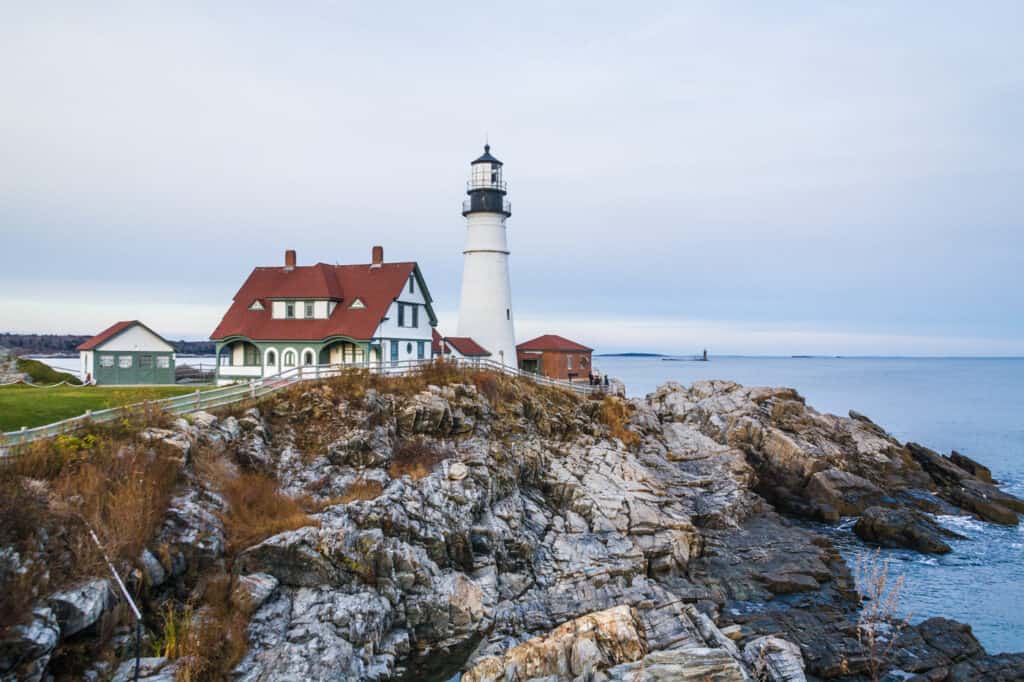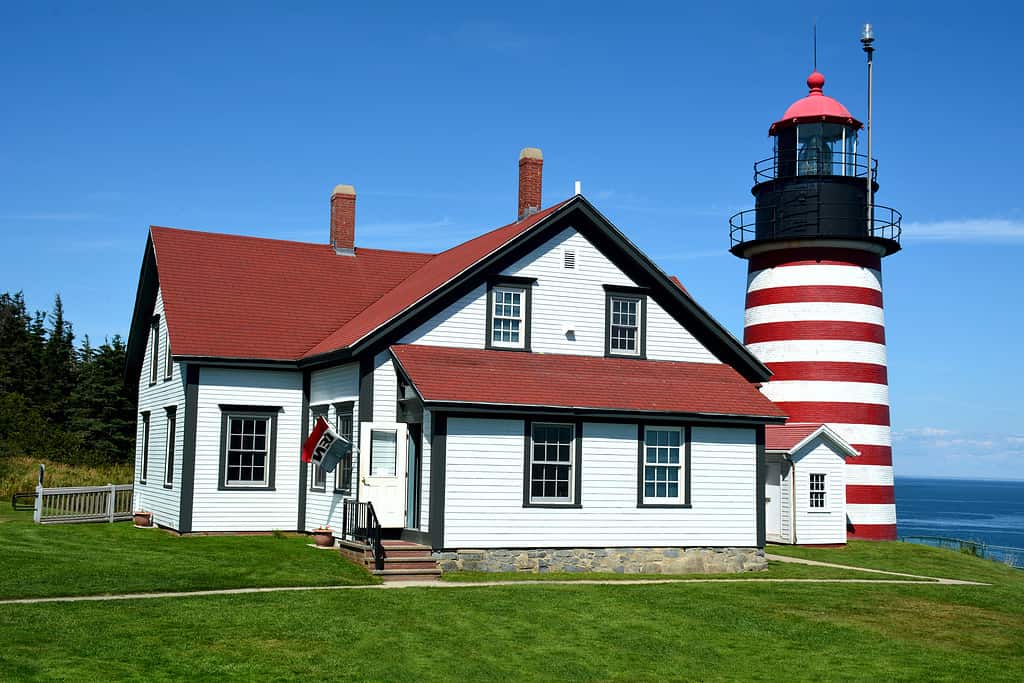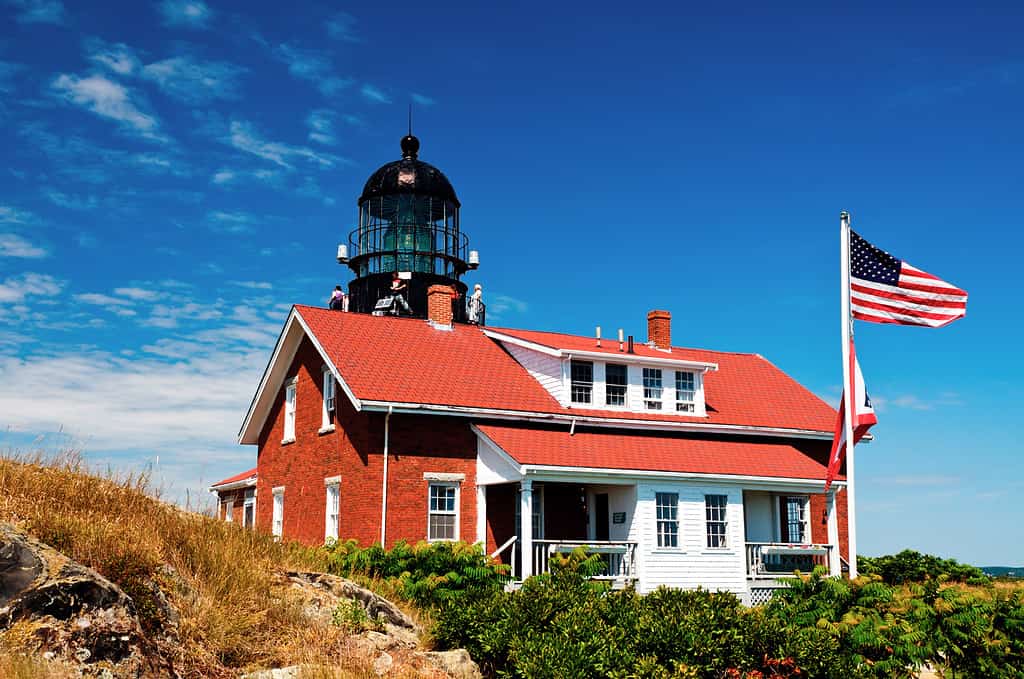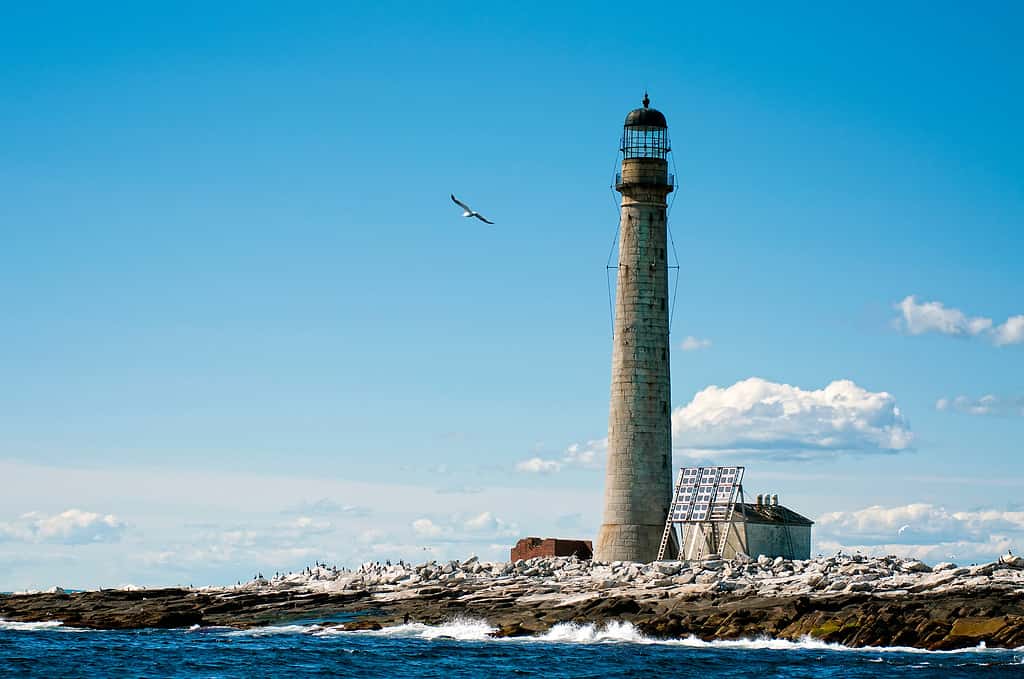Welcome to the mesmerizing world of Maine’s lighthouses, where towering beacons stand tall, like noble sentinels of the sea, ready to guide lost ships and enrapture curious souls. With their stoic presence and enchanting tales of maritime lore, these lighthouses add a touch of magic to the rugged coastal landscape. Amidst crashing waves and salty air, these charming guardians of the sea beckon you to explore their secrets, with promises of breathtaking views, eerie ghost stories, and more lobster rolls than you can possibly devour. So grab your binoculars, a sense of adventure, and maybe even a crustacean-themed hat. Let’s embark on a lighthouse-hopping extravaganza that will visit the six most beautiful Maine Lighthouses.
The Six Most Beautiful Maine Lighthouses: History
Lighthouses have played a vital role in the history of Maine, with its extensive coastline and rocky shores.
The first lighthouse in Maine was the Portland Head Light, located in Cape Elizabeth, just south of Portland. It was commissioned by President George Washington in 1787 and became operational in 1791.
The Portland Head Light served as a critical aid to navigation for ships entering Portland Harbor and also helped prevent numerous shipwrecks along the treacherous coast. In the early 19th century, as Maine’s maritime trade and fishing industries grew, the need for additional lighthouses became evident.
The U.S. government responded by constructing numerous lighthouses along the Maine coastline to improve safety and navigation. These lighthouses not only served as navigational aids but also became beloved symbols of Maine’s coastal beauty.
Lighthouse Keepers and Advances in Technology
Maintaining and operating lighthouses was no easy task. Many lighthouses had resident keepers. They and also their families lived on-site and were responsible for tending to the lights and maintaining the structures. In the early years, lighthouses were often fueled by whale oil, which later gave way to kerosene, and then electric lamps.
The development of advanced navigation technology, including radar and GPS, rendered many lighthouses less critical for maritime safety. As a result, several lighthouses in Maine were automated, and the role of resident keepers was rendered obsolete. However, these structures’ historical significance and aesthetic appeal led to their preservation and continued public interest.
Today, many lighthouses in Maine have been designated as historic landmarks and are open to the public. Visitors can explore these beacons of maritime history, learn about the lives of lighthouse keepers, and also enjoy stunning coastal views. In addition, some lighthouses even have museums or visitor centers that offer insights into their rich past
Portland Head Light
Portland Head Light is one of the most iconic and historic lighthouses in Maine. Located in Cape Elizabeth, just south of Portland, it holds a significant place in the maritime history of Maine as the first and oldest lighthouse in the state. It was commissioned by President George Washington in 1787 and lighted for the first time in 1791. Its primary purpose was to guide ships safely into the entrance of Portland Harbor, which was a major center for trade and commerce during that time.
The lighthouse sits atop a rocky headland overlooking the Atlantic Ocean, providing a commanding view of the surrounding coastline. The tower itself stands at a height of 80 feet (24 m) and is constructed of rubblestone. Originally, it housed a whale oil lamp, which was later replaced by a Fresnel lens.
In addition, one of the distinctive features of Portland Head Light is its white conical tower. It contrasts beautifully with the rugged natural surroundings.
Witness To History
Portland Head Light has witnessed many significant historical events. During the War of 1812, a British naval bombardment targeted the lighthouse, but it withstood the attack. The lighthouse continued to serve as a critical navigational aid throughout the 19th and early 20th centuries, guiding ships and protecting them from the treacherous coastline. In addition, the light was fully automated in 1989, ending the era of resident keepers who had maintained the light for generations.
Today, Portland Head Light is owned by the town of Cape Elizabeth and also managed by the nonprofit organization Portland Head Light Keepers. The lighthouse hosts approximately one million visitors each year, drawn not only by its historical significance but also by its stunning coastal setting. The surrounding Fort Williams Park provides a picturesque backdrop for the lighthouse, with walking trails, picnic areas, and scenic viewpoints for visitors to enjoy.
Visitors can explore the lighthouse grounds, which include a museum located in the former keeper’s quarters. The museum exhibits artifacts, photographs, and historical information about the lighthouse and its keepers. Additionally, it offers a glimpse into the daily lives of the individuals who tended the light and the important role they played in ensuring maritime safety. Visitors are not allowed to climb the tower.
Portland Head Light has also inspired artists and photographers, who capture its beauty in various forms of artwork. Its image has appeared on postcards, calendars, and in countless photographs, making it one of the most recognizable lighthouses in the country.

Portland Head Light is one of the most iconic and historic lighthouses in Maine.
Bass Harbor Head
The enchanting Bass Harbor Head Light is one of Maine’s most beloved lighthouses. Located in Tremont, on the southwest corner of Mount Desert Island, this iconic beacon has captured the hearts of visitors and locals alike. Standing proudly at a height of 32 feet (9.75 m), this historic lighthouse was first illuminated in 1858. In addition, its distinctive appearance showcases a white cylindrical tower made of brick, topped with black lantern housing.
Perched on rugged granite cliffs overlooking the Atlantic Ocean, Bass Harbor Head Light offers breathtaking panoramic views of the surrounding coastline. The scene is completed by the charming keeper’s dwelling adjacent to the tower, which has stood the test of time as a testament to the lighthouse’s rich history.
Additionally, Bass Harbor Head Light is a working lighthouse that continues to guide vessels through the treacherous waters near Mount Desert Island. Its powerful beacon, with a range of approximately 15 miles, helps ships navigate the rocky shoreline. Visiting Bass Harbor Head Light is a treat for the senses. You can soak in the views, listen to the crashing waves, and perhaps catch a glimpse of seabirds soaring above. It’s a place where history, nature, and also beauty converge, leaving visitors with lasting memories.

Bass Harbor Head Light is a working lighthouse that continues to guide vessels through the treacherous waters near
Mount Desert Island
.
©Jon Bilous/Shutterstock.com
West Quoddy Head
West Quoddy Head Light is a charming lighthouse perched on the easternmost point of the United States in Lubec, Maine. This iconic light holds the distinction of marking the point where the nation’s day begins. The sun first rises on the American mainland at this very spot. Towering at an impressive height of 49 feet (15 m), the West Quoddy Head Light has been guiding mariners since 1808.
The lighthouse’s tower stands tall, painted in a striking red and white stripe pattern. This helps distinguish it from other lighthouses along the coast. In addition, one of the unique features of West Quoddy Head Light is its distinctive third-order Fresnel lens.
The lens was installed in 1858 and remains in operation today. This impressive lens, known for its intricate prism design, emits a powerful beam of light. The beam reaches a distance of 15 nautical miles, guiding ships safely along the treacherous coastline. Finally, West Quoddy Head Light was fully automated in 1988.
The lighthouse complex includes a resident keeper’s house, which has been restored to reflect its original 19th-century charm. Visitors can step inside and learn about the fascinating history of the lighthouse through informative exhibits and displays. The tower is not open for climbing. The surrounding Quoddy Head State Park provides ample opportunities for hiking, picnicking, and also exploring the natural beauty of the area.

The West Quoddy Head Light tower stands tall, painted in a striking red and white stripe pattern. This helps distinguish it from other lighthouses along the coast.
©James W. Thompson/Shutterstock.com
Pemaquid Point
Pemaquid Point Light is a gem nestled on the rugged shores of Bristol. This enchanting lighthouse, perched on a rocky promontory, is a true sight to behold. The lighthouse at Pemaquid Point stands at a height of 38 feet (11.5 m). Its white tower reaches toward the sky as a beacon of safety for mariners navigating the nearby waters. Additionally, it was first illuminated in 1827, making it one of Maine’s oldest lighthouses.
The lighthouse structure itself is made of rubble stone and concrete and showcases a classic New England architectural style. The tower is adorned with a black lantern room housing the light. In addition, it emits a distinctive white flash every six seconds, ensuring its visibility to passing ships.
Perched atop the tower, the fourth-order Fresnel lens. Originally installed in 1856, it is still in use today, guiding vessels with a range of approximately 14 nautical miles. This lens, with its intricate prisms and reflective surfaces, stands as a testament to the craftsmanship of the era. Pemaquid Point Light was automated in 1934. It is also featured in the Maine state quarter.
Beyond its iconic tower, Pemaquid Point Light boasts stunning natural beauty. The surrounding area offers breathtaking views of crashing waves against rocky cliffs and the open expanse of the Atlantic Ocean. Visitors can explore the nearby Pemaquid Point Park. It features walking trails, picnic areas, and also a museum that delves into the lighthouse’s history. So, pack your camera, bring your sense of wonder, and be captivated by the timeless allure of Pemaquid Point Light. In addition, there is a 46-inch (1.1 m) height requirement to climb the tower.

Pemaquid Point Light is a gem nestled on the rugged shores of Bristol.
©davidmarxphoto/Shutterstock.com
Seguin Island
Seguin Island Light is a beacon of seafaring history located on Seguin Island, off the coast of Phippsburg, Maine. This majestic lighthouse stands proudly on one of the highest points along the rocky coastline, offering panoramic views of the Atlantic Ocean and also the surrounding islands. Its white tower, made of granite blocks, stands at 64 feet (9.5 m). It is a testament to its resilience against the powerful ocean forces that have battered the light since it was constructed in 1857.
The light is housed in a black lantern room, which completes the lighthouse’s distinctive appearance. Today, it serves as an active aid to navigation, guiding ships through the treacherous waters of the Kennebec River and the Gulf of Maine. Fully automated in 1985, Seguin Island Light is the only lighthouse in Maine with a first-order Fresnel lens.
Remote Location
What sets Seguin Island Light apart is its remote location. The island is accessible only by boat or helicopter, adding to its sense of seclusion and adventure. As you approach the island, you’ll be greeted by the sight of the lighthouse, perched atop the rocky cliffs. Visiting Seguin Island offers an opportunity to step back in time and experience the life of a lighthouse keeper.
The keeper’s house, built in the 19th century, has been restored. The downstairs portion now serves as a museum. Inside, you can explore exhibits that showcase the history of the lighthouse, the daily lives of the keepers, and the maritime heritage of the region. If you’ve ever dreamt of spending the night in a lighthouse, Sequin Island offers you the chance! The upstairs of the keeper’s house has been converted to accommodate guests.
Membership in the Friends of Seguin Island is required to take advantage of this singular opportunity. Members also receive 10% off in the gift shop and 20% off ferry transportation to and from the island, so what are you waiting for? Whether you’re a history buff, a nature lover, or simply seeking an escape from the modern world, Seguin Island Light offers an unforgettable experience.

©Allan Wood Photography/Shutterstock.com
Boon Island
The Boon Island Light is, fittingly enough, located on Boon Island, approximately six miles (10 km) off the coast of York, Maine. Boon Island itself is a small, rocky island that measures 300 ft (91 m) by 700 ft (210 m) at low tide. The need for navigational aid to warn ships of the treacherous waters around Boon Island became evident following numerous shipwrecks in the area. In 1811, the U.S. government decided to construct a lighthouse on the island to improve maritime safety.
The original Boon Island Light was a stone tower, standing approximately 32 feet (9.7 m) tall, topped with a lantern room housing a whale oil lamp. It became operational in January 1812, with its light visible for about 15 miles. In addition, the tower was rebuilt to a height of 49 feet (15 m) in 1831. The present light, standing 133 feet (40.5m) was completed in 1855. Its impressive height makes Boon Island Light the tallest lighthouse in Maine.
Isolation and Harsh Conditions
The isolation and also harsh conditions of Boon Island posed significant challenges for the lighthouse keepers. The island is subjected to intense storms, frigid temperatures, and relentless waves, making it a challenging place to live and work. Over the years, the lighthouse underwent several changes and improvements.
After the keeper’s quarters were destroyed in a blizzard, Boon Island Light was automated in 1980, marking the end of the resident keepers’ era. Today, Boon Island Light remains an active aid to navigation, operated by the U.S. Coast Guard. Due to its remote location, Boon Island is not accessible to the public. However, visitors can catch glimpses of the lighthouse from viewpoints along the coast or by boat tours that pass by the island.

The present light, standing 133 feet (40.5m) was completed in 1855. Its impressive height makes Boon Island Light the tallest lighthouse in Maine.
©Allan Wood Photography/Shutterstock.com
Thank you for reading! Have some feedback for us? Contact the AZ Animals editorial team.








